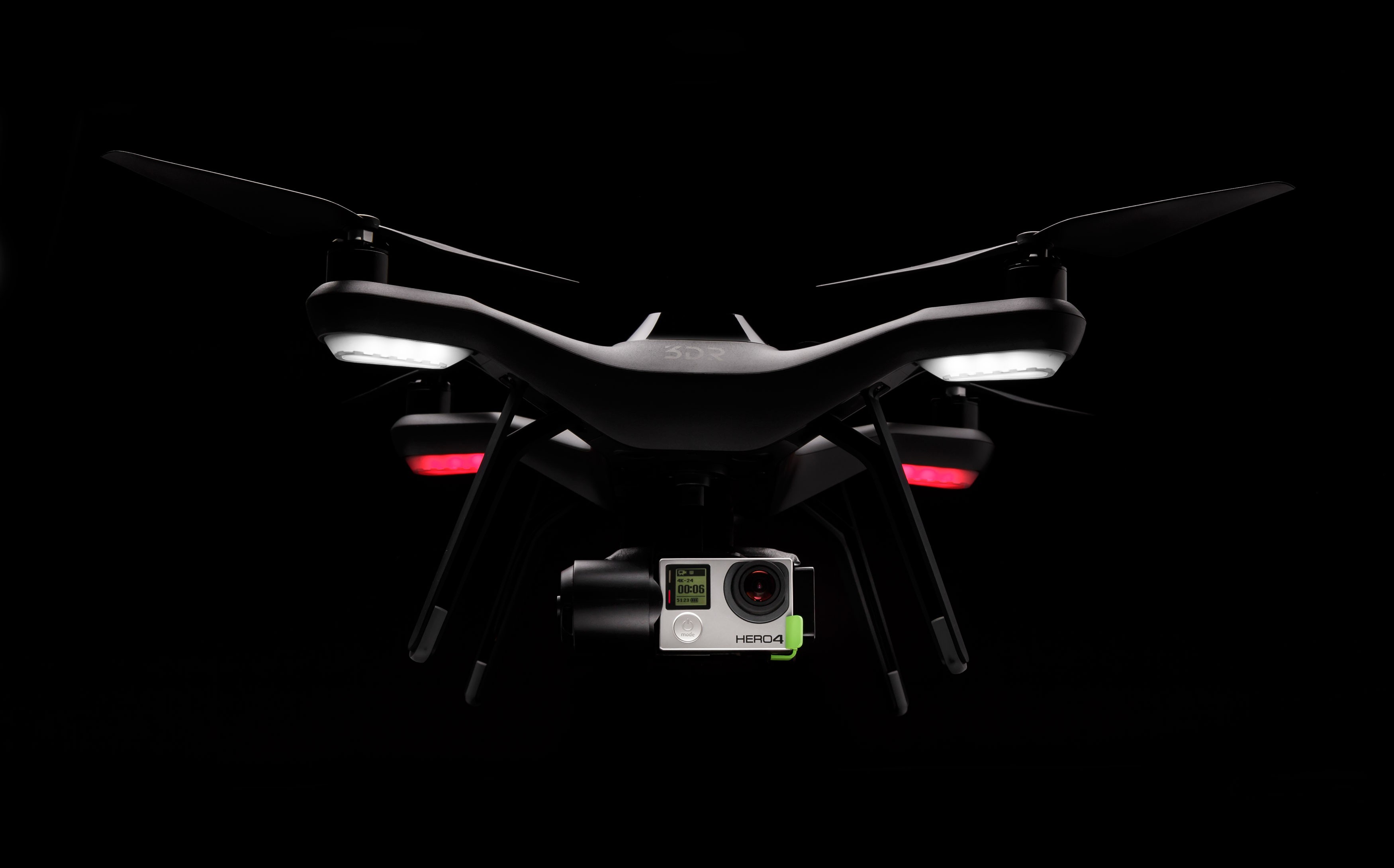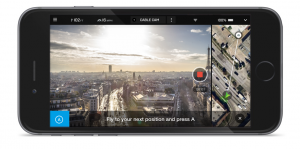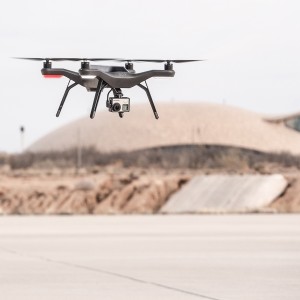Original post by Eric Brown on Linux.com

3DRobotics Solo quadcopter is its first Linux-based drone. Image credit: 3D Robotics.
3DRobotics today announced its first Linux-based drone, a Solo quadcopter touted as the first Unmanned Aerial Vehicle (UAV) to support full control of GoPro cameras and deliver live-streaming HD video to mobile devices. The ground controller, as well as the onboard computer connected to the drone’s Pixhawk 2 autopilot, integrates a 1GHz Cortex-A9 computer running Linux. The Solo is available for pre-sale at $1,000, or $1,400 with a GoPro gimbal, with units shipping via 2,000 locations starting May 29.
The Solo’s computers are more powerful than those of 3DR’s usual APM (ArduPilot Mega) open source drone and autopilot kits, which run the Nuttx RTOS on Arduino hardware. The Solo’s onboard “brainstem” autopilot flight computer is closely linked via WiFi to the ground controller’s “frontal cortex” system, “dramatically reducing the likelihood of autopilot system failure during flight,” according to 3DR.
The Linux computers enable greater autonomy and ease of use than earlier 3DR models such as the $750-and-up Iris+ or the newer, $1,350-and-up X8+ octocopter, says 3DR. The Solo can automatically takeoff, return home, and land, among other features.
Wireless video
The Solo is claimed to be the world’s first drone to wirelessly transmit HD video from a GoPro to an iOS or Android device from up to half a mile, which it does with a claimed latency of 180 milliseconds. (According to Engadget, this is actually 720p, rather than 1080p HD.) Industry leader DJI announced a somewhat similar feature last week with its new Phantom 3 drone, which is claimed to zap live

The Solo is claimed to be the world’s first drone to wirelessly transmit HD video from a GoPro to an iOS or Android device from up to half a mile.
HD video to you from up to 1.2 miles (see farther below).
In conjunction with GoPro cameras, the Solo controller lets you start and stop recording video while in flight, as well as easily pre-program aerial camera shots. These so-called Smart Shots routines include a follow-me mode, as well as filming along a virtual track of waypoints. There’s also an orbiting mode that focuses on an object while circumnavigating it, and a selfie establishing shot that backs up and away from you. Some of these features appear to require the $399 GoPro camera gimbal, which keeps the camera image stable with under 0.1 degree pointing accuracy.
The GPS-enabled Solo can fly 25 minutes without a camera or other payload (1,500 grams), or 20 minutes with the GoPro and its gimbal (1,800 g), says 3DR. Its “smart battery” communicates with the device’s computers to warn you when it’s time to head home.
Like the Phantom 3, as well as other consumer drones, the Solo ships with a controller designed to fit an Android or iOS device as a display. The mobile app lets you take still photos, change the FOV and frame rate, and adjust exposure and other settings.
The Solo’s controller features WiFi and a micro-HDMI port, so you can also directly feed live video to a monitor or FPV goggles. A small built-in display is provided, along with dedicated buttons that enable direct hands-on flight when the drone is flying nearby. There’s even a panic button that stops the drone and directs it to hover in midair.
Solo first to run Dronecode via DroneKit SDK
There was little talk of Linux last October when 3DR and the Linux Foundation launched the Dronecode Project as a community project and governance body for APM. The Berkeley, Calif.-based 3DR did say, however, that it was working to port Linux to its open source APM platform. It also announced plans to integrate a Linux-based companion computer for its advanced Iris+ drone using an Intel Atom Edison module.

The GPS-enabled Solo can fly 25 minutes without a camera or other payload (1,500 grams), or 20 minutes with the GoPro and its gimbal (1,800 g), says 3DR.
The Solo, however, is a much more ambitious dive into Linux. It’s only the second Linux-on-APM drone we know of after Erle Robotics’ hobbyist Erle-Copter. Other
Linux-based quadcopters include the slightly lower end Parrot BeBop.
With the help of Dronecode, and 3DR’s DIY Drones community, the company has for several years offered open source hardware and software UAV autopilot designs to the
hobbyist community. Like 3DR’s commercially sold Iris+ and x8+, however, it appears that access to parts of the Solo will be opened only to selected developers.
The Solo runs apps developed with a recently released, open source DroneKit SDK and web API, backed by the Dronecode Foundation. A “Made for Solo” development
program, meanwhile, is “aimed at enabling small companies with great ideas to work directly with us and our manufacturing partners on developing and launching
fantastic new accessories,” says 3DR.
It’s unclear how deeply 3DR will open the Solo hardware, and to whom exactly. So far, the company has yet to reveal many detailed specs. Yet, the design is clearly
designed to be expandable.
The quadcopter integrates a gimbal bay, an accessory bay, and “easy-to-swap motor pods with integrated speed controllers,” says 3DR. The gimbal bay will be enable manufacturers to create plug-and-play gimbals or imaging devices as an alternative to GoPro, complete with “HD feed to Solo’s mobile app, full camera control, and even access to Solo’s computing power,” says the company.
The accessory bay will be similarly opened to gizmos like optical flow indoor flight stabilizers, ballistic parachute systems, and LED lighting system. The swappable motor pods will eventually support upgraded propulsion systems, says 3DR.
Phantom 3 pushes to 4K
Even if the Solo is not entirely open source, it’s almost certainly more accessible than the Phantom 3. DJI’s latest quadcopter will ship with an SDK for mobile app development, but it’s otherwise a very proprietary platform.
I was intrigued by several reports from hackers that have claimed the Phantom 2 is based on OpenWRT Linux. (Examples can be found here, here, here, and here.) However, when I asked DJI Creative Director Sheldon Schwartz last week at the Phantom 3 launch event in New York, he said there was no Linux in the Phantom 3 or controller.
Whatever is under the hood of the Phantom 3, it will be tough for 3DR’s Solo to beat. Even if you already own a GoPro, the Phantom 3 is cheaper, since it ships with a built in camera and s gimbal for $999. A $1,259 Pro version gives you a 4K camera. In addition to the HD video transmission feature, the Phantom 3 also introduced a vision positioning system that can help the quadcopter navigate in areas with poor GPS reception.
On the other hand, Phantom 3 doesn’t have anything quite like Smart Shots, such as waypoint or follow-me modes. According to a favorable hands-on story about the Solo by The Verge, the Solo was largely shaped by DJI expat Colin Guinn, now Chief Revenue Officer at 3DR.
To give it a boost in its battle with the Phantom, 3DR is offering a 30-day money-back guarantee, as well as a free replacement if Solo breaks in flight. Meanwhile, the future looks bright for both products. In the U.S., the FAA continues to expand exemptions on commercial use, and last week, it allowed Amazon to test its promised delivery drones.



